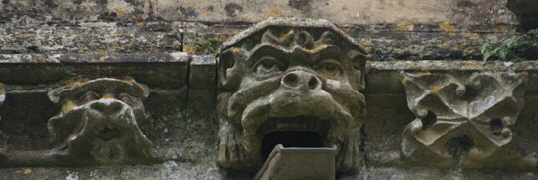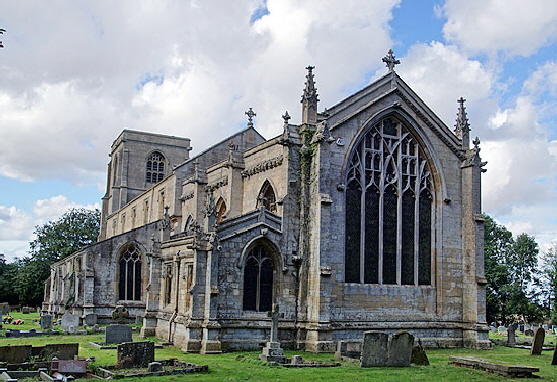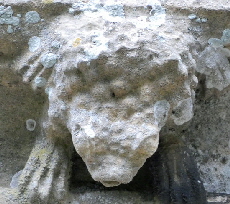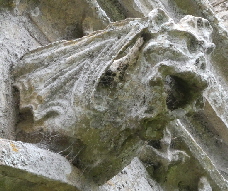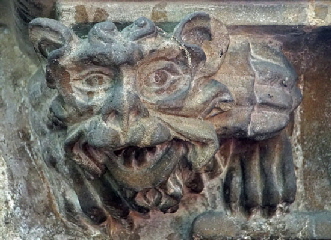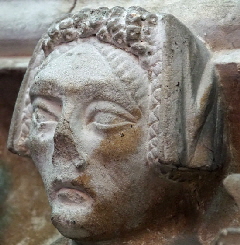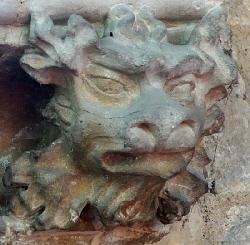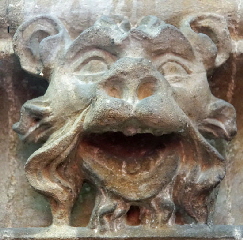 |
|
Alphabetical List
|
 |
|
County List and Topics
|
|
|
|
 |
|
The villages around the former port of Boston were blessed with large and impressive church buildings. They are real testament I think to the prosperity that will have spread from Boston itself, in mediaeval times one of the richest towns in England that celebrated that fact with a parish church that claims to be the largest in England and with undoubtedly its biggest tower. Leverton is one of those satellite villages. It is seven miles to the east of Boston, just two or three miles as the crow flies from the sea. It is a little-visited area and I rather imagine that the village will be surprised to see its church described on these pages. It is large, impressive but seemingly with little of real interest.
And yet this church was my big “find” during the lockdown period. Because here I discovered what was the furthest-flung site of work by the sculptural mason I call “John Oakham” who was sometime member of the “Mooning Men Group”, the subject of my “Bums, Fleas and Hitchhikers” on this site. Moreover, as we shall see, the man also worked inside the church as well as outside. More of that anon.
The church presents a fiercely Perpendicular face to the world. The east window is perhaps its best feature; it is imposing with good tracery, but this is a nineteenth century replacement. The three stage fifteenth century tower is oddly is strangely austere, lacking battlements, spire or pinnacles. Most windows are rectangular including the clerestory and it dates only from 1892.
|
|
 |
 |
|
As a building you might call it “dignified”, even stately. Perhaps even boring. All that stateliness is undone, however, by the chancel. English Heritage list it as late fourteenth century. This might be right, but it could equally be early fifteenth. For here we find a cornice frieze with fine sculptures carved by the aforementioned John Oakham. English Heritage (shame on them) list the the carvings as being “corbels” but the frieze has no functional use: it is merely decoration The pinnacles and buttresses also have a riot of sculpture. The overall effect on this building is like seeing your granny in a mini-skirt! Pevsner suggests that the chantry chapel on the south east corner was built for the man that paid for the chancel. That is undoubtedly true for although it has no cornice frieze it does have other carvings and label stops by John Oakham.
Pevsner describes the church as having a Perpendicular exterior but a Decorated interior. Both aisles are fourteenth century. It must be said, however, that the interior is as vanilla as most of the exterior. Pevsner, with his unrivalled eye for changing architectural fashion, says that the south aisle preceded the north and that is building was from west to east. The proportions are grand, the chancel arch noble with a fifteenth century screen and the tower arch and west window are conspicuously large but there is little to set the pulse racing. Except, that is, for the triple sedilia.
The sedilia is an oasis of flamboyance with ogee arches and the usual flamboyant flourishes. Above all of that is a little cornice frieze with eight floral and grotesque carvings. And those carvings match those on the outside of the chancel and are undoubtedly also by John Oakham. There is no possible room for doubt. John also obliges us with a couple of other internal sculptures. All of this is in his inimitable style seen to best effect at Oakham in Rutland fifty miles away and at Brant Broughton in Lincolnshire, thirty five miles away.
|
 |
 |
|
Leverton Church and John Oakham
John Oakham was a member of the “Mooning Men Group” of stonemasons who plied their trade - as a collective - far to the west, identified by their iconic “mooner” trademark Even within that group, John had his personal trademark carving - the “flea” (or is it a toad as my friend Bonnie Killingback insists?). You can see it on several - although frustratingly not all - of the churches at which he sculpted. And here at Leverton, bless him, he left us another on the north side cornice
|
|
|
 |
 |
|
John’s is an extraordinary story. I can confidently assert that nobody has been able previously to track a parish church mason in this way. It is his distinctive decorative that has allowed me to do this. I was able to do the same for four other masons within the Mooning Men Group and some of them are more prolific that John within that area. But those other seem to have not strayed far from home; they may have been peripatetic but they also would have had permanent homes to which they would return home during downtime and in between jobs. John, however, ventured far. He worked at the huge rebuilding of Boston Church but did not leave a flea/toad and he worked at Swineshead where he did carve one. The cornice frieze here is his as is the sedilia inside the church.
The carvers of cornice friezes were not usually decorative sculptors by profession: they were undoubtedly common masons able to add decoration as required. Not were they “Master Masons”. John, however, seems to have made much of this decorative competence and his friezes at Brant Broughton are so extensive and so well-executed that we have to surmise that he may
|
|
 |
 |
|
have been in demand sometimes for this purpose.
Gratifyingly - bearing in mind the remoteness of the location - his work at Leverton is amongst his best; perhaps second only to Brant Broughton although less extensive than at, for example, Oakham. What is also exciting here, however, is that we can unequivocally place him as a man who decorated within churches as well as outside. All common sense tells you this must be the case but similarities in less numerous internal carvings make this difficult. I have only previously been able to definitely attribute to him the baptismal font at Muston, with a strong likelihood for the similarly weird fonts at Harlaxton and Allington in the same area.
At Leverton, as at the other churches, masons did not just turn up to do a bit of sculpture - at least not a parish churches. John Oakham’s opportunity at Leverton was with the rebuilding of the chancel and, as previously noted, the chantry chapel. Had Pevsner not been so careless about decorative sculpture he would have realised this for himself!
|
|
|
 |
 |
|
The rather cheerful little dragon (left) on the east wall of the chantry is very clearly in John Oakham’s style and proves that chancel and chantry were contemporaries. As always, it is an open question what other work John was performing here. It is my contention that no mason could make a long-term living from decorating parish churches (as opposed to cathedrals). John might well have been working as a structural mason here as well.
John was al Boston, Swineshead and Leverton. There are other cornice friezes in this part of Lincolnshire including at Kirton, Gosberton, and Old Leake. None of these friezes were definitely by John Oakham although I believe Old Leake only two miles north of Leverton to be a strong candidate. Did John Oakham bring the concept of cornice frieze decoration with him from churches further west in Rutland and surrounding areas and “sell” it to the contractor-masons and their patrons? Extensive cornice friezes are not common. I believe that John was probably instrumental in creating the fashion in the East Midlands.
|
|
 |
 |
|
To read the “Bums, Fleas and Hitchhikers” story CLICK HERE. To skip the main narrative and just find more about John Oakham CLICK HERE,
|
 |
 |
|
Leverton - the Frieze
Many of John Oakham’s friezes are instantly recognisable even in the absence of his trademark flea/toad carving. Many of his grotesque faces look like cow-human hybrids. In between those are fleurons and whatever grotesquery took his fancy. The frieze is a high quality one. This is not only in terms of the carvings, but also the spacing. It is also densely packed with carving and Brant Broughton is the only other to stand comparison. The stone has weathered well, especially compared with nearby Boston whose friezes have suffered badly.
|
 |
 |
|
Four lengths of the Leverton chancel frieze. The cow/human faces are much in evidence. Note the “flush gargoyle in the same style in the picture lower right.
|
 |
 |
|
The Leverton Sedilia
|
 |
Leverton, the Church
|
 |
|
 |
 |
 |
 |
 |
 |
 |
 |
 |
 |
 |
 |
 |
 |
 |
 |
 |
 |
 |
 |
 |
 |
 |
 |
|
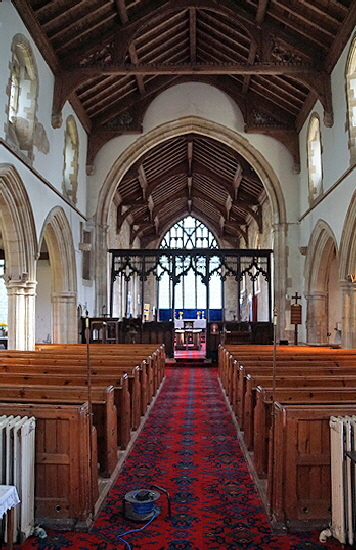 |
|
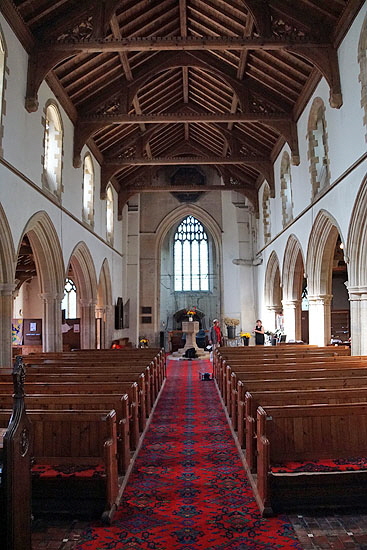 |
|
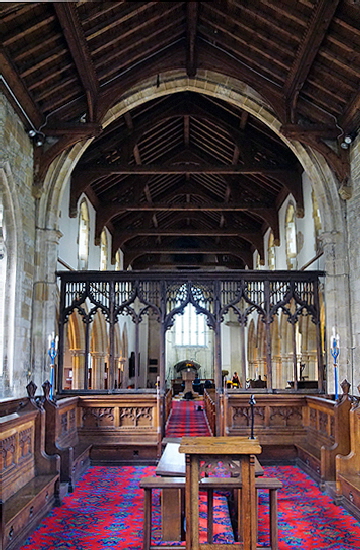 |
|
|
|
Left: This is an unusual church as it features wall-to-wall carpets. This is the view to the east, Note the loftiness of the chancel arch and, indeed, the chancel itself leading to a very light church. The rather plain screen is mediaeval. Centre: The view to the west, and the similarly lofty tower arch with a tall west window beyond it. The clerestory is tall. This is one of the lightest churches you will find. The arcades are well ordered and although not symmetrical they complement each other nicely. Right: The view from the altar, looking west, and showing the cosy little seating area within the chancel.
|
|
|
|
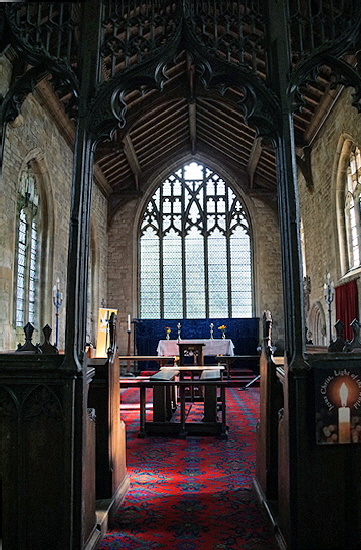 |
|
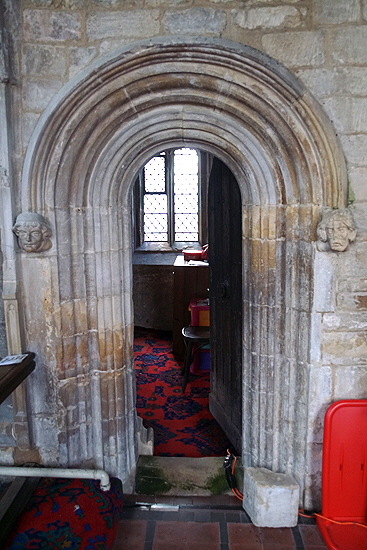 |
|
 |
|
|
|
Left: The chancel. It is a huge space. Note on the right the doorway through to the chantry chapel. Centre: The doorway to the chapel is an unusual one: with a round arch centuries after the introduction of pointed Gothic ones. Even the chantry has been visited by CarpetRight! Right: The north aisle looking east.
|
|
|
|
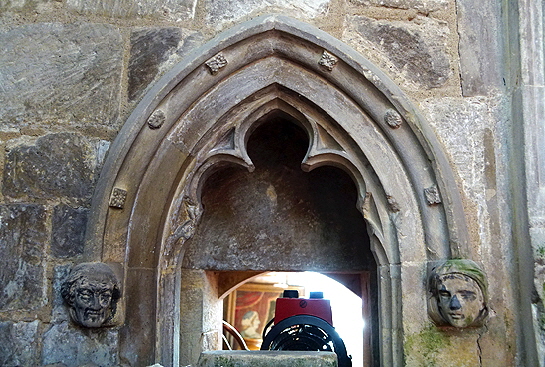 |
|
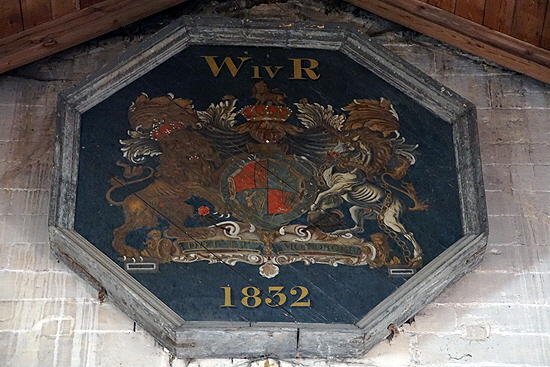 |
|
|
|
Left: This is an odd little affair. This is a piscina in the north wall of the chancel but, as you can see, it also has an opening through to the chantry chapel, presumably acting as an auxiliary squint. This would have been used, one presumes, so that the raising of the host at the two altars could be synchronised. Right: If there is not a society specialising in the celebration of royal coats of arms in parish churches, this being my beloved eccentric England, then I would be surprised! I really like this one of William IV. It has an unusual shapes, is nicely painted and hat lettering is so of its time. It begs a question. When we see royal arms, such as this one, in a parish church what happened to the previous ones? Or were there no previous ones? Just askin’! By the way, for those that have not worked it out yet, royal arms assert the supremacy of the Crown over the Church. Another Henry VIII legacy.
|
|
|
|
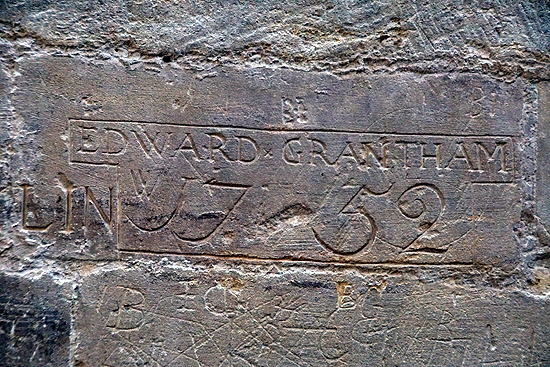 |
|
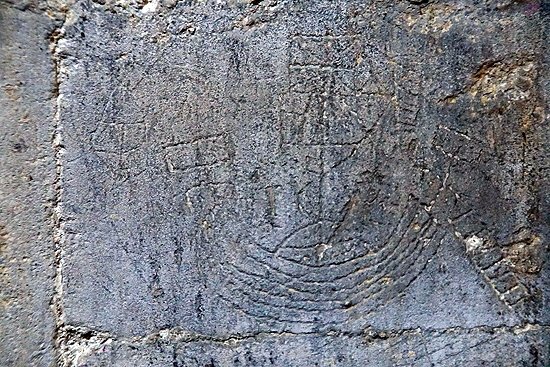 |
|
|
|
I was indebted to the churchwarden for pointing out the graffiti in the south porch wall. Looking at Edward Grantham’s moniker (left) I can’t help wondering at the time this must have taken to incise such deep cuts. he intended his graffiti to last, didn’t he? And look at the precision of the letter and number forms! This guy was almost a calligrapher in stone and, thus, probably a pillar of the community, not some spotty youth with a kitchen knife. It must have taken considerable time and it would have been immediately visible. Such impunity! Was it condoned by the parish and churchwardens and, if so, why? The ship outline (right) is much less precise. although it doesn’t look like a five minute job either. As a depiction of a ship, it is peculiar with absurdly curved hull. A very unseaworthy vessel! A merchant vessel, I think, as gun ports would have been easy to carve. Leverton is only a couple of miles from the sea. How old is this? I am guessing Tudor while nearby Boston was still a busy port,
|
|
|
|
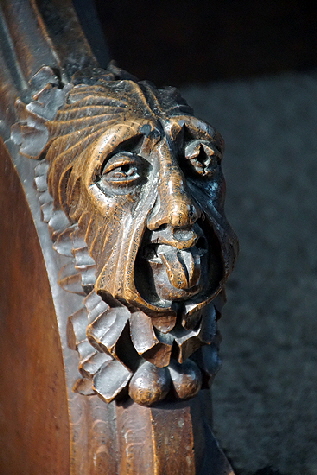 |
|
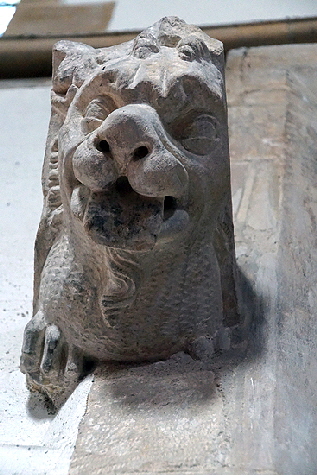 |
|
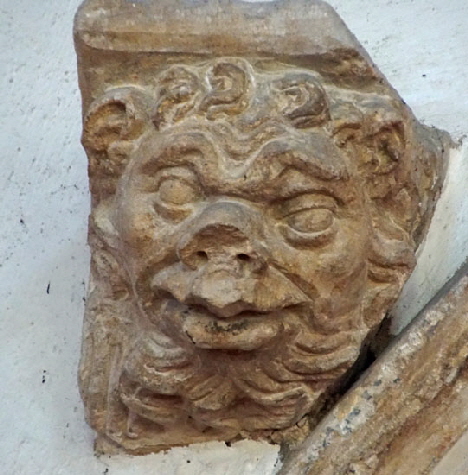 |
|
|
|
Left: Armrest carving. Centre: A very obvious large John Oakham grotesque near the rood loft. This one is a happy little chap. Right: Another John Oakham face opposite on the south side. Not for the first time, we must ask what these two are doing here? They have no meaning (no - they really don’t!) and no function yet here they are in prominent positions near the chancel arch.
|
|
|
|
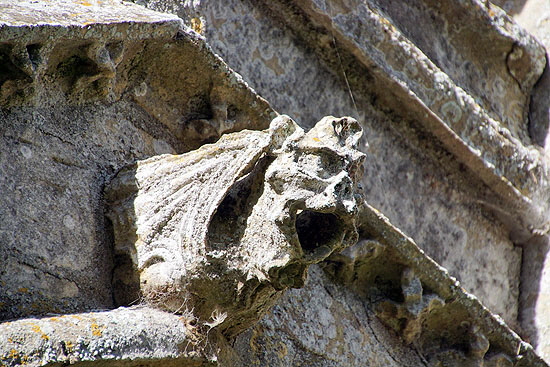 |
|
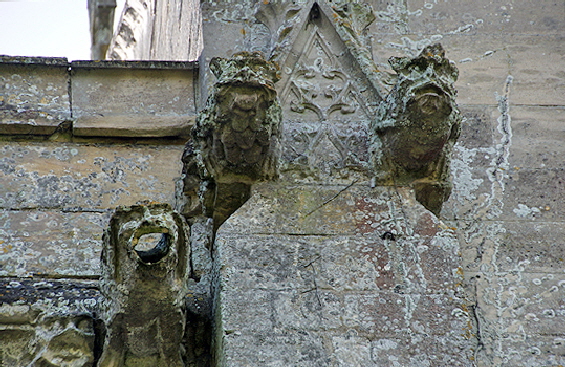 |
 |
 |
|
Left: Another look at John Oakham’s dragon over the centre of the east window of the chantry chapel. It sits in a simple fleuron frieze. Right: Buttress carvings by John Oakham on the chantry chapel.
|
|





